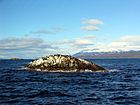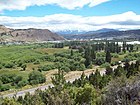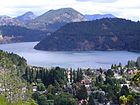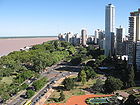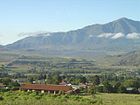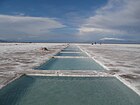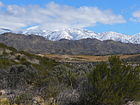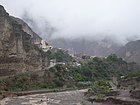Tourism in Argentina: Difference between revisions
No edit summary |
No edit summary |
||
| Line 8: | Line 8: | ||
Mainly for its beautiful landscapes and then for its cultural heritage, Argentina is receiver of massive amounts of travellers: the Argentine territory stretches from the highest peaks of the [[Andes]] in the west to the great rivers and extensive beaches and cliffs of [[Argentine Sea]] in the east; from the tropical rainforest of the [[Yungas]] north to the valleys, [[glacier]]s, lakes and [[Bosque Andino Patagónico|cold forests]] of [[Andean Patagonia]] in the south, and to [[Argentine Antarctica]]. Through the warm landscapes of tropical climates contrasting, in a huge gradient [[microclimate]]s, the [[polar climate]]s or extensive and very fertile [[Temperate grasslands, savannas, and shrublands|grasslands]]s with the World´s most flatter plains contrasting with the highest mountains outside Asia, contrasted with also vast desert areas plethoric of [[geoform]]s for the annual running extensive and extreme [[Dakar Rally|Dakar rally race]], the high mountain ranges, the pleasant [[Sierras pampeanas|Pampeanas mountains]] and the temperate Atlantic beaches and its extensive coastlines. The huge distances require in most cases air travel. The [[Misiones rainforest]], Argentine Yungas and areas of the [[Andean Patagonia|Argentine Andean Patagonia]] are scientifically considered as [[Biodiversity hotspot|biodiversity hotspots]] large areas worldwide. The great [[biodiversity]] and the large number of different [[landscape]]s and [[Climate of Argentina|climate]]s make Argentina a diverse country where appear to meet multiple countries together harmoniously (fertile temperates, deserts, cold forest, warm tropicals and subtropical jungles, [[glacier]] areas, [[forest|cold forest]]s, maritimes with [[cliff]]s, [[ria]]s and [[fjord]] s etc.). |
Mainly for its beautiful landscapes and then for its cultural heritage, Argentina is receiver of massive amounts of travellers: the Argentine territory stretches from the highest peaks of the [[Andes]] in the west to the great rivers and extensive beaches and cliffs of [[Argentine Sea]] in the east; from the tropical rainforest of the [[Yungas]] north to the valleys, [[glacier]]s, lakes and [[Bosque Andino Patagónico|cold forests]] of [[Andean Patagonia]] in the south, and to [[Argentine Antarctica]]. Through the warm landscapes of tropical climates contrasting, in a huge gradient [[microclimate]]s, the [[polar climate]]s or extensive and very fertile [[Temperate grasslands, savannas, and shrublands|grasslands]]s with the World´s most flatter plains contrasting with the highest mountains outside Asia, contrasted with also vast desert areas plethoric of [[geoform]]s for the annual running extensive and extreme [[Dakar Rally|Dakar rally race]], the high mountain ranges, the pleasant [[Sierras pampeanas|Pampeanas mountains]] and the temperate Atlantic beaches and its extensive coastlines. The huge distances require in most cases air travel. The [[Misiones rainforest]], Argentine Yungas and areas of the [[Andean Patagonia|Argentine Andean Patagonia]] are scientifically considered as [[Biodiversity hotspot|biodiversity hotspots]] large areas worldwide. The great [[biodiversity]] and the large number of different [[landscape]]s and [[Climate of Argentina|climate]]s make Argentina a diverse country where appear to meet multiple countries together harmoniously (fertile temperates, deserts, cold forest, warm tropicals and subtropical jungles, [[glacier]] areas, [[forest|cold forest]]s, maritimes with [[cliff]]s, [[ria]]s and [[fjord]] s etc.). |
||
The country presents entire range of possible climates: temperate, dry warm, humid warm, cold dry, cold humid, semi-arid, steppe, subantarctic, subtropical, snowy, cold mountain, and a huge variety of [[microclimate]]s. |
|||
Argentina has enjoyed the visit of 5.80 million tourists in the year 2011 according to the [[World Tourism Organization]], the first most visited country in South America and the second most visited of all of Latin America, after [[Mexico]]..<ref name="OMT2008">{{cite web|url=http://www.tourismroi.com/Content_Attachments/27670/File_633513750035785076.pdf||title=UNWTO World Tourism Barometer June 2008 |publisher=UNWTO |date=2008 |author=World Tourism Organization |language=English |accessdate=August 5, 2008}}Volume 6 No. 2 Page 30</ref> |
|||
Foreign tourists mainly come from [[Brazil]], [[Chile]], [[Uruguay]], [[Paraguay]], [[Bolivia]], [[Peru]], [[Ecuador]], [[ Colombia]], [[Venezuela]], [[Costa Rica]], [[Mexico]], [[Cuba]], [[Dominican Republic]], [[US]], [[Canada]], [ [China]], [[South Korea]], [[Japan]], [[Australia]] and Europeans from [[Spain]], [[Italy]], [[France]], [[Germany]], [[United Kingdom]], [[Ireland]], [[Netherlands]], [[Belgium]], [[Switzerland]], [[Portugal]] and [[Russia]]. |
|||
==Main destinations== |
|||
[[File:Buenos Aires-Retiro(CatalinasNorte)-P3090002.JPG|thumb|Buenos Aires, ''La Reina del Plata''.]] |
|||
* '''City of [[Buenos Aires]]''', considered, mainly to architecture, the "Paris of America" offers a wide cultural activity. Travelers usually choose a night visit to the locals where dancing [[tango]] and a walk to a typical [[estancia]] (in the [[Province of Buenos Aires]]), to taste the traditional [[asado]]. In recent years, emerged new themed tours, including many dedicated to important personalities like [[Carlos Gardel]], [[Eva Perón]] or [[Jorge Luis Borges]]. It also has numerous shopping walks, among which include the Alto Palermo, Paseo Alcorta, Patio Bullrich, [[Abasto de Buenos Aires]] and [[Galerías Pacífico]]. |
|||
[[File:Iguazú-Argentinia-001.JPG|thumb|left|View of a small part of the gigantic Iguazú Falls, [[Misiones Province]].]] |
|||
* '''[[Iguazú Falls]]''', located in the northeast, area of subtropical [[Paraná forest|forest]], are the [[waterfalls]]s best known throughout the region and its tourist exploitation has good infrastructure development, and with very different walks. Is Area of [[National Park]], where the original flora and fauna are preserved. Its most impressive fall is called [[Devil's Throat|Garganta del Diablo]]. Other important are called Dos Hermanas, Bossetti or Álvar Núñez in honor of its discoverer, [[Álvar Núñez Cabeza de Vaca]]. |
|||
[[File:Salta - Convento de San Francisco - Nocturno.jpg|thumb|[[Basilica and Convent of San Francisco (Salta)|Church of San Francisco]] in [[Salta]], the highest church bell of [[South America]].]] |
|||
[[File:ViñedoCafayate.jpg|thumb|left|Vineyard in [[Cafayate]], [[Province of Salta]]]] |
|||
* '''[[Salta]]''' City of colonial architecture with tourist attraction since it can make tours to other touristic points as: [[Quebrada de San Lorenzo]], [[Calchaquí Valleys]], [[Reservoir Cabra Corral]] (Embalse General Belgrano), [[Cafayate]], [[Salinas Grandes (Jujuy and Salta)|Salinas Grandes]], [[Iruya]] (step bound by the [[Quebrada de Humahuaca]] and [[Purmamarca]]) [[Cachi, Argentina|Cachi]] (through the [[Cuesta del Obispo]]) [[Molinos, Salta|Molinos]], [[La Caldera]], [[Los Cardones National Park]], [[El Rey National Park]] or [[Baritú National Park]], hot springs of [[Rosario de la Frontera]]. It leaves from the center of the city the [[Tren a las Nubes]]; this particular train ride through the area of the [[Puna de Atacama|Puna]], an almost desert plateau, with huge contrasts in its route that goes up the slopes of the Andes, located in the province of Salta. Its service was interrupted momentarily in [[July]] of [[2005]] for repairs, reactivated quickly. Currently, the final destination is the city of [[San Antonio de los Cobres]]. |
|||
[[File:Perito Moreno Glacier Patagonia Argentina Luca Galuzzi 2005.JPG|thumb|left|The [[Perito Moreno Glacier]] in summer.]] |
|||
* '''[[Perito Moreno Glacier]]''', forming part of [[Southern Patagonian Ice Field]] is a huge glacier that bisects the [[Argentino Lake]] and cyclically locks until it produces the breaking of the ice plug. It is located in the '''[[Los Glaciares National Park]]''' near the still small (though highly developed) Argentine Patagonian city of [[El Calafate]]. In any season of the year are produced continuous landslides of huge blocks of ice from massive glaciers (only comparable to the glaciers of Antarctica and other polar glaciers) forming beautiful [[iceberg]]s in Argentine lakes, which is a natural show. The Perito Moreno Glacier and its neighbors is framed by a majestic landscape of rugged mountains like the [[Fitz Roy|Chaltén]] and large lakes. |
|||
[[File:Ruta Nacional 40 km 1930.jpg|thumb|left|[[National Route 40 (Argentina)|National Route 40]] in its 1930 km (of more than 5,000 km of track).]] |
|||
[[File:Catedral de San Carlos de Bariloche.JPG|thumb|left|Cathedral of [[Bariloche]].]] |
|||
* '''[[Bariloche]]''': this city is the capital of the southern lakes and important part of the tourist circuit of the Seven Lakes with [[Villa La Angostura]]. Today, thanks to the investments of entrepreneurs and of municipality has a large tourist flow throughout the year. The main activities include winter sports, fishing, windsurfing, trekking or hiking, camping in the Andean forest, sky diving, boat tours and private boats, horseback riding and scuba diving, among others. Similar to [[San Martín de los Andes]], [[Junín de los Andes]], [[El Bolsón, Río Negro|El Bolsón]], [[Esquel]], [[Trevelin]], [[Los Antiguos]] activities are also developed [[Copahue, Argentina|Copahue]], [[Caviahue, Argentina|Caviahue]]. |
|||
[[File:Ushuaia 2009.jpg|thumb|left|The city of [[Ushuaia]] in summer, in the [[Tierra del Fuego Province, Argentina|Province of Tierra del Fuego, Antarctica and South Atlantic Islands]].]] |
|||
* '' '[[Ushuaia]]' '', the southernmost city in the world, in [[Province of Tierra del Fuego, Antarctica and South Atlantic Islands|Tierra del Fuego]], typical destination of the south of the country, attracts visitors with a very important tourist with excursions, gastronomy and the feeling of being literally at the end of the world. North of the island, the city of [[Río Grande, Tierra del Fuego|Rio Grande]] is attractive by his old neighborhood of wooden houses painted varied or subtly and by excellent trout fishing. Further south, it is famous railway from [[Ushuaia]] and reaches the [[Tierra del Fuego National Park]], bayside of [[Lapataia]]. Cruises are also offered by the [[Beagle Channel]], observing colonies of [[Otaria flavescens|South American sea lion]]s, and a visit to [[Faro Les Eclareurs]], the beautiful [[Cami Lake|Lake Fagnano]] (or Kami) or almost inaccessible [[Isla de los Estados|Staten Island]] where is the [[Lighthouse of the End of the World]], the landscape of fueguinos forests takes an almost magical appearance during the austral autumn to be covered with reddish the foliage of the dense forests. |
|||
==Overview== |
==Overview== |
||
Revision as of 03:04, 1 August 2015
This article has multiple issues. Please help improve it or discuss these issues on the talk page. (Learn how and when to remove these template messages)
|

The Argentina is provided with a vast territory and a huge variety of climates and microclimates ranging from snowy climate, polar and subpolar in the south to the tropical climate in the north, through a vast expanse of temperate climate and natural wonders like the Aconcagua, the highest mountain in the world outside the Himalayas, the widest river and estuary of the planet (the River Plate), the huge and very mighty Iguazú Falls, some of the flattest and wide meadows-plains of planet Earth (as the Humid Pampas, a large ocean-sea coast in the Argentine Sea), culture, customs and gastronomies famous internationally, a higher degree of development (very high compared to other Latin American countries), good quality of life and people, and relatively well prepared infrastructure make this country one of the most visited of America.
Mainly for its beautiful landscapes and then for its cultural heritage, Argentina is receiver of massive amounts of travellers: the Argentine territory stretches from the highest peaks of the Andes in the west to the great rivers and extensive beaches and cliffs of Argentine Sea in the east; from the tropical rainforest of the Yungas north to the valleys, glaciers, lakes and cold forests of Andean Patagonia in the south, and to Argentine Antarctica. Through the warm landscapes of tropical climates contrasting, in a huge gradient microclimates, the polar climates or extensive and very fertile grasslandss with the World´s most flatter plains contrasting with the highest mountains outside Asia, contrasted with also vast desert areas plethoric of geoforms for the annual running extensive and extreme Dakar rally race, the high mountain ranges, the pleasant Pampeanas mountains and the temperate Atlantic beaches and its extensive coastlines. The huge distances require in most cases air travel. The Misiones rainforest, Argentine Yungas and areas of the Argentine Andean Patagonia are scientifically considered as biodiversity hotspots large areas worldwide. The great biodiversity and the large number of different landscapes and climates make Argentina a diverse country where appear to meet multiple countries together harmoniously (fertile temperates, deserts, cold forest, warm tropicals and subtropical jungles, glacier areas, cold forests, maritimes with cliffs, rias and fjord s etc.).
The country presents entire range of possible climates: temperate, dry warm, humid warm, cold dry, cold humid, semi-arid, steppe, subantarctic, subtropical, snowy, cold mountain, and a huge variety of microclimates.
Argentina has enjoyed the visit of 5.80 million tourists in the year 2011 according to the World Tourism Organization, the first most visited country in South America and the second most visited of all of Latin America, after Mexico..[2]
Foreign tourists mainly come from Brazil, Chile, Uruguay, Paraguay, Bolivia, Peru, Ecuador, Colombia, Venezuela, Costa Rica, Mexico, Cuba, Dominican Republic, US, Canada, [ [China]], South Korea, Japan, Australia and Europeans from Spain, Italy, France, Germany, United Kingdom, Ireland, Netherlands, Belgium, Switzerland, Portugal and Russia.
Main destinations

- City of Buenos Aires, considered, mainly to architecture, the "Paris of America" offers a wide cultural activity. Travelers usually choose a night visit to the locals where dancing tango and a walk to a typical estancia (in the Province of Buenos Aires), to taste the traditional asado. In recent years, emerged new themed tours, including many dedicated to important personalities like Carlos Gardel, Eva Perón or Jorge Luis Borges. It also has numerous shopping walks, among which include the Alto Palermo, Paseo Alcorta, Patio Bullrich, Abasto de Buenos Aires and Galerías Pacífico.

- Iguazú Falls, located in the northeast, area of subtropical forest, are the waterfallss best known throughout the region and its tourist exploitation has good infrastructure development, and with very different walks. Is Area of National Park, where the original flora and fauna are preserved. Its most impressive fall is called Garganta del Diablo. Other important are called Dos Hermanas, Bossetti or Álvar Núñez in honor of its discoverer, Álvar Núñez Cabeza de Vaca.


- Salta City of colonial architecture with tourist attraction since it can make tours to other touristic points as: Quebrada de San Lorenzo, Calchaquí Valleys, Reservoir Cabra Corral (Embalse General Belgrano), Cafayate, Salinas Grandes, Iruya (step bound by the Quebrada de Humahuaca and Purmamarca) Cachi (through the Cuesta del Obispo) Molinos, La Caldera, Los Cardones National Park, El Rey National Park or Baritú National Park, hot springs of Rosario de la Frontera. It leaves from the center of the city the Tren a las Nubes; this particular train ride through the area of the Puna, an almost desert plateau, with huge contrasts in its route that goes up the slopes of the Andes, located in the province of Salta. Its service was interrupted momentarily in July of 2005 for repairs, reactivated quickly. Currently, the final destination is the city of San Antonio de los Cobres.

- Perito Moreno Glacier, forming part of Southern Patagonian Ice Field is a huge glacier that bisects the Argentino Lake and cyclically locks until it produces the breaking of the ice plug. It is located in the Los Glaciares National Park near the still small (though highly developed) Argentine Patagonian city of El Calafate. In any season of the year are produced continuous landslides of huge blocks of ice from massive glaciers (only comparable to the glaciers of Antarctica and other polar glaciers) forming beautiful icebergs in Argentine lakes, which is a natural show. The Perito Moreno Glacier and its neighbors is framed by a majestic landscape of rugged mountains like the Chaltén and large lakes.


- Bariloche: this city is the capital of the southern lakes and important part of the tourist circuit of the Seven Lakes with Villa La Angostura. Today, thanks to the investments of entrepreneurs and of municipality has a large tourist flow throughout the year. The main activities include winter sports, fishing, windsurfing, trekking or hiking, camping in the Andean forest, sky diving, boat tours and private boats, horseback riding and scuba diving, among others. Similar to San Martín de los Andes, Junín de los Andes, El Bolsón, Esquel, Trevelin, Los Antiguos activities are also developed Copahue, Caviahue.

- 'Ushuaia' , the southernmost city in the world, in Tierra del Fuego, typical destination of the south of the country, attracts visitors with a very important tourist with excursions, gastronomy and the feeling of being literally at the end of the world. North of the island, the city of Rio Grande is attractive by his old neighborhood of wooden houses painted varied or subtly and by excellent trout fishing. Further south, it is famous railway from Ushuaia and reaches the Tierra del Fuego National Park, bayside of Lapataia. Cruises are also offered by the Beagle Channel, observing colonies of South American sea lions, and a visit to Faro Les Eclareurs, the beautiful Lake Fagnano (or Kami) or almost inaccessible Staten Island where is the Lighthouse of the End of the World, the landscape of fueguinos forests takes an almost magical appearance during the austral autumn to be covered with reddish the foliage of the dense forests.
Overview
The World Economic Forum estimated that, in 2006 tourism generated around US$25 billion in economic turnover, and employed 1.8 million. Domestic tourism amounted to over 80% of this and tourism from abroad contributed US$4.3 billion, becoming the third largest source of foreign exchange in 2004. Around 4.6 million foreign visitors arrived in 2007, yielding a positive balance vis-à-vis the number of Argentines traveling abroad.[3] [4][5] Argentina has been upgrading its worldwide presence as a tourism destination by increasing the investment on international tourism. The latest push can be seen by Aerolineas Argentinas, the country's national airline, adding international routes from the United States and Europe. There are also rumors that they will join a major airline alliance soon.
INDEC recorded 2.3 million foreign tourist arrivals in 2007 (a 12% increase), at the Ministro Pistarini International Airport, alone (around half the total); of these, 26% arrived from Brazil, 25% from Europe, 14% from the United States and Canada, 8% from Chile, 19% from the rest of the Western Hemisphere and 8% from the rest of the World.[6]
| Internl. tourist arrivals 2007 (x1000)[4] |
Internl. tourism receipts 2007[4] (million USD) |
Receipts per arrival 2007 (col 2)/(col 1) (USD) |
Arrivals per capita per 1000 pop. (estimated) 2007[4][7] |
Receipts per capita 2007[8] USD |
Revenues as % of exports goods and services[7] 2007 |
Tourism revenues as % GDP[5] 2007 |
% Direct & indirect employment in tourism[5] 2008 |
- align="center" | 4,562 | 4,313 | 945 | 116 | 109 | 7.8 | 1.6 | 10.5 | 65 |
|---|
The country had 5.28 million international visitors in 2010, up from 4.3 million in 2009. Argentina ranked as the top destination in South America, and second in Latin America after Mexico in 2010, in terms of the international tourist arrivals. Revenues from international tourists reached US$4.93 billion in 2010, up fromUS$396 billion in 2009.[9]
Tourist regions

The Tourism in Argentina is divided in six regions:[1] Buenos Aires (consisting of Buenos Aires City and Buenos Aires Province), Córdoba, Cuyo, The North, Litoral and Patagonia.
Buenos Aires

Buenos Aires is in the midst of a tourism boom, according to the World Travel & Tourism Council,[10] it reveals strong growth for Argentina Travel and Tourism in 2007 [11] and in coming years, and the prestigious travel and tourism publication; Travel + Leisure Magazine, a monthly publication leader in the world-wide market of travel magazines, travelers voted Buenos Aires the second most desirable city to visit after Florence, Italy.[12] Buenos Aires, regarded as the “Paris of South America,” offers elegant architecture, exquisite cuisine, a legendary nightlife, and fashionable shopping.
The most popular tourist sites are found in the historic city core, comprising Montserrat and San Telmo. The city was originally constructed around the Plaza de Mayo, the administrative center of the Spanish Empire. To the east of the square is the Casa Rosada, the official seat of the executive branch of the government of Argentina. To the north, the Catedral Metropolitana which has stood in the same location since colonial times, and the Banco de la Nación Argentina building, a parcel of land originally owned by Juan de Garay. Other important colonial institutions were Cabildo, to the west, which was renovated during the construction of Avenida de Mayo and Julio A. Roca. To the south is the Congreso de la Nación (National Congress), which currently houses the Academia Nacional de la Historia (National Academy of History). Lastly, to the northwest, is City Hall.
Avenida de Mayo links the Casa Rosada with the Argentine National Congress. On this avenue there are several buildings of cultural, architectural and historical importance, such as Casa de la Cultura, the Palacio Barolo and Café Tortoni. Underneath the avenue, the first subte (metro) line ![]() in South America, was opened in 1913. The avenue ends at Plaza del Congreso, which features a number of monuments and sculptures, including one of Auguste Rodin's few surviving original casts of "The Thinker."
in South America, was opened in 1913. The avenue ends at Plaza del Congreso, which features a number of monuments and sculptures, including one of Auguste Rodin's few surviving original casts of "The Thinker."
The Manzana de las Luces ("Illuminated Block") area features the San Ignacio church, the Colegio Nacional Buenos Aires, and the old city council building (1894 to 1931). This area features tunnels and catacombs, which crossed underneath the Plaza de Mayo during colonial times. In the neighbourhood of San Telmo, Plaza Dorrego hosts an antiques fair on Sundays, complete with tango shows. They also have tango shows daily at the famous plaza. On weekends they involve many tourists to learn how to dance. Frequent tours and activities are also available at the Church of Nuestra Señora de Bethlehem, the San Pedro Telmo Parish and the Antonio Ballvé Penintetiary Museum. The National Historical Museum in Parque Lezama is a few blocks south. The Ayres Porteños Hostel is a very famous hostel as it is also a tourist attraction, it is decorated and painted by artists from La Boca and possesses a unique collection of local paintings among its walls.
The borough of Recoleta is home to a number of places of interest, including the Museo Nacional de Bellas Artes, the Biblioteca Nacional, the Centro Cultural Recoleta, the Faculty of Law of the Universidad de Buenos Aires, the Basílica Nuestra Señora de Pilar, the Palais de Glace, the Café La Biela and the Cementerio de la Recoleta, where Eva Perón's crypt can be visited, among those of many other Argentine historical and cultural figures.
Buenos Aires Province

The Province of Buenos Aires is the most populous and largest province of Argentina (if territorial claims in the Antarctica and South Atlantic islands are not taken into account). The nation's rail and road network fans out from Buenos Aires and into the province, the area centered around the Pampas. This region is characterized by its estancias (large cattle ranches) the oldest of them being featured in architectural styles, located in the middle of the Pampas. The province is also known by its many and different beaches in the coast of the Atlantic Ocean (the most visited being Mar del Plata). The hilly region of Tandil and Ventana offers golf courses, paragliding rides and trekking. They are very different landscapes from each other and distant from the mouth of the Paraná River, which islands are also visited by tourists.
Córdoba

The Córdoba Province is one of the most important economic centers in the country. It has with many contrasting features— it is both a cultural and tourist-like destination, a traditional and modern city, with an industrialized as well as a home-made production. Large portions of landscape and favorable weather conditions are distinctive in Córdoba, natural sceneries are mixed with colonial monuments. Little towns, historical antiques and cave paintings are found in a pleasant valley landscape, high plains and gorges. Sierras de Córdoba rise toward the northwestern Pampas plains. They are part of the “Sierras pampeanas” mountain range, reaching 2,790 m high in the Champaqui hill. These hills are fertile valleys, deserts and salt mines. All along the way northward, many 17th and 18th century chapels and farmhouses inherited from the Jesuits can be found.
The Jesuit estancias (large cattle ranches) in Córdoba are a singular sample of the productive organization of the religious members of Compañía de Jesús in the country, and this can still be seen in a preserved architecture. Though history demonstrated that the farms were acquired for economic purposes in order to support schools and universities, the estancias were of course used “for missionary purposes, thus turning into religious centers.” Estancias in Jesús María, Caroya, Santa Catalina, La Candelaria and Alta Gracia can be visited along a 250 km circuit. These farms that date back to the 17th century —together with the Jesuit Block in the City of Córdoba— are all national historical monuments that were declared World Cultural Heritage in 2000.
Cuyo
The Cuyo region consists of the provinces of La Rioja, San Juan, Mendoza and San Luis.[13]
Cuyo is the region of the high peaks, the snow-covered volcanoes, and the large wilderness spreading from the Andes mountain range and foothills to the steppe. The visit to Ischigualasto - Talampaya Natural Parks is an historical path trough Argentinean history of palaeontology. Ischigualasto, also known as “Valle de la Luna” (Moon Valley) because of the diversity of forms and colours of its landscape shaped by erosion, is one of the world’s most important paleontologic sites. The Talampaya River Canyon reveals multi-shaped layers in its high red walls. Pink flamingos, Andean ducks, “vicuñas” and “guanacos” cohabit freely in parks and natural reserves, while condors fly over the area. The region displays the full splendour of the Central Andean Range. The Aconcagua (6,959 m) is the highest peak in the Western Hemisphere, and its steep slopes are renowned and respected by mountain climbers worldwide. In the valleys of La Rioja, Mendoza and San Juan, among leaves of grapevines, farms and wineries, visitors can go along the Wine Road.
The North


The North (Spanish: El Norte) consists of the provinces of Jujuy, Salta, Catamarca, Tucumán and Santiago del Estero.[14]
Northern provinces feature traces of pre-Columbian cultures, mingled with ruins of natives’ villages, as well as forts and constructions dating back to the time of the Conquest and Colonization. In the high plateau of the Puna, a land full of mountain ranges, steep mountain paths, and gorges. Villages have been built in the small valleys. Multi-coloured and monochromatic hills covered with huge cactuses on the slopes surround the village. This region offers landscapes full of contrast, from the high peaks to the salt pans, and the subtropical rain forests, where Latin American culture took root.
An ample diversity of natural landscapes and dramatic contrasts such as the densely vegetated Yunga forests, or the mountains, hills and brooks of the Calchaquí Valleys, provide great conditions for sport fishing. The rivers Juramento, Lipeo, Iruya and Bermejo are home to the dorado, and the mountain river rapids support trout. The whole region combines natural attractions with suitable areas for diverse activities such as mountaineering, trekking, horseback riding, mountain biking, ecotourism, bird-watching, rural tourism, and archeological trips. Sailing, canoeing and windsurfing are other sports that may be practiced in this region.
Destinations of interest in this region are the Train to the Clouds, which offers a view to the stark contrasts of the province of Salta; the Quebrada de Humahuaca, which was declared a World Heritage Site in 2003, the Calchaquí Valleys, that ranges from the mountain desert to the subtropical forest; Pucará de Tilcara, a fort built by the humahuacas; Cafayate; Iruya; Cachi; and Tafí del Valle, among others.
Litoral

The "Litoral", Spanish for littoral, consists of the provinces of Chaco, Corrientes, Entre Ríos, Formosa, Misiones and Santa Fe.[15] This is a region of large rivers, humid tropics, red earth and a virgin forest full of huge trees and important flora and fauna.
The Iguazú Falls on the border with Brazil are one of the world's natural wonders. Lined with dense forests, the Iguazú river flows into 275 waterfalls, plunging more than 70 meters with a deafening noise. As this huge volume of water reaches the bottom, spray rises, and rainbows are formed in the sky. A variety of fauna and flora completes the setting for the waterfalls within the protection of the Iguazú National Park. This park, located at eighteen kilometres from Puerto Iguazú, was declared Natural Heritage of Humanity by UNESCO. The famous falls are inside this park. The deep flowing waters of the river fall from a height of 70 metres through 275 falls over 2.7 km. The frontier with Brazil goes through the Garganta del Diablo (Devil's Throat). The National Park is full of the exotic subtropical vegetation which surrounds the falls and has 2,000 plant species - gigantic trees, ferns, lianas, orchids, - 400 bird species - parrots, hummingbirds, toucans - jaguars and yacarés (caimans).
Lying on the bluffs of the Paraná river, Posadas, capital city of Misiones and bordering with Encarnación (Paraguay), has its Plaza 9 de Julio, as well as museums and artisan markets. If the course of the river is followed in a south-west direction, the Yacyretá hydroelectric plant, which is one of the biggest in the world, can be reached.
Many ruins of the ancient Jesuit missions - some of which have been covered by the jungle - are located near Posadas. The most well-known ruins are in San Ignacio Miní, 56 km away from the province’s capital. The ones in Candelaria, Loreto, Santa Ana and Santa María are also very interesting. These Jesuit reductions were declared World Heritage by the UNESCO.
Fifty kilometers to the north of Colón lies El Palmar National Park, housing the last samples of Yatay palm trees, which are almost eight centuries old. The city of Concordia is connected to the city of Salto (Uruguay) through the Salto Grande hydroelectric plant.
The Esteros del Iberá, a humid zone of 700.000 hectares can be reached from Posadas, Concepción or Mercedes. In Guaraní, Iberá means "Shining water". Its lagoons cover 31,500 hectares, its marshlands 52,000, and its inlands 260,000. This eco-system which gives life to turtles, yacarés (caimans), monkeys, swamp deer, capybaras - the largest rodent in the world - and up to 400 bird species, besides an extraordinary flora, extends over one million hectares.
The city of Rosario lies on the banks of the Paraná River in the Province of Santa Fe. It has developed into an industrial and commercial center and destination for a significant number of people on business. On its riverside promenade stands the Monumento Nacional a la Bandera (National Monument to the Flag), where the Argentine National Flag was raised for the first time. Parque Independencia has an artificial lake, statues, a racecourse, and the Provincial History Museum.
Patagonia

The patagonic region consists of the provinces of La Pampa, Neuquén, Río Negro, Chubut, Santa Cruz and Tierra del Fuego.[16]
- Los Glaciares National Park, is the place where glaciers drain the Southern Patagonian Ice Field into the Lago Argentino, blocking one of its bays until the pressure of the water blows the ice dam. You can access the park via the city of Calafate. One of the most popular attractions is the Perito Moreno Glacier.
- Ushuaia, the southernmost city in the world, located in Tierra del Fuego, is a typical destination in southern Patagonia.
- Bariloche - San Carlos de Bariloche is a city in the Río Negro Province, situated on the foothills of the Andes, surrounded by lakes (Nahuel Huapi, Gutiérrez Lake, Moreno and Mascardi Lake) and mountains (Tronador, Cerro Catedral, Cerro López). It is famous for skiing but also great for family trips for older children and sight-seeing, water sports, trekking and climbing. Cerro Catedral is one of the most important ski centers in South America.
- Punta Tombo is a coastal location where abundant wildlife congregates-specifically the seasonal breeding ground of large numbers of Magellanic penguins.[17]
- Peninsula Valdés is widely considered to be one of the best places in the world for the observation of wildlife, mainly sea mammals. Although Southern Right Whales are the main attraction elephant seals, sea lions, Magellanic penguins and orcas are also well represented.
- Santa Cruz Province is known for its remoteness and for landmarks such as the Perito Moreno Glacier, Laguna del Carbon (the lowest geographical point in the Americas), Mount Fitz Roy, and the Petrified Forests National Monument, as well as the vast patagonian plateau and pebble beaches.
Other destinations in the region include seaside Las Grutas (in Río Negro), Rada Tilly; The Aconcagua, the highest mountain in the western hemisphere and nearby Las Leñas ski resort; Villa La Angostura, San Martín de los Andes, Junín de los Andes, El Bolsón, Esquel, Trevelin, Los Antiguos, Copahue, Caviahue, near snow-capped mountains with temperate rainforests and glacial lakes; San Rafael and Mendoza, where the best wines of Argentina are made.
Tourism centering around fauna is also popular, particularly whale-watching in Puerto Madryn.
World Heritage
These are the UNESCO's World Heritage Sites in Argentina:[18]
- Cave of the Hands (Cueva de las Manos), Río Pinturas. Has prehistoric cave paintings (WHS since 1999).
- Iguazú National Park, home of Iguazu Falls (1984).
- Ischigualasto / Talampaya National Parks and its paleontologic formations (2000).
- Jesuit Block and Estancias of Córdoba in Córdoba Province (Cultural Heritage) (2000).
- Jesuit missions of the Guaranis: San Ignacio Mini, Santa Ana, Nuestra Señora de Loreto and Santa Maria Mayor (1984).
- Los Glaciares National Park and the Perito Moreno Glacier (1981).
- Península Valdés, a marine wildlife preserve (1999).
- Quebrada de Humahuaca, World Cultural Landscape for its scenic natural beauty and historical sights (2003).
-
Jesuit Missions of the Guaranis (San Ignacio Miní, Santa Ana, Nuestra Señora de Loreto and Santa María la Mayor)
-
Tango (UNESCO Intangible Cultural Heritage)
National Parks

Argentina has an extensive National Park system, preserving sights of natural beauty, which includes the following:
- Baritú National Park
- El Leoncito National Park
- El Palmar National Park
- El Rey National Park
- Iguazú National Park
- Lanín National Park
- Los Alerces National Park
- Los Arrayanes National Park
- Los Cardones National Park
- Nahuel Huapi National Park
- San Guillermo National Park
- Talampaya National Park
- Tierra del Fuego National Park
Government Tourism Agencies
The Secretariate of Tourism was promoted to a full cabinet ministry in June 2010, naming Enrique Meyer the Minister of Tourism. Leonardo Boto is the Chairman of the National Institute of Tourism Promotion.
Safety and security

The U.S. Department of State warns travelers in Argentina that "drivers frequently ignore traffic laws[19] and vehicles often travel at excessive speeds . . . traffic accidents are the primary threat to life and limb in Argentina."[20] Argentina has the highest traffic mortality rate in South America, with Argentine drivers causing 20 deaths each day (about 7,000 a year), with more than 120,000 people injured or maimed each year. These deaths have included tourists from various parts of the world.[21] Pedestrians should exercise extreme caution.
Ethical Traveler Destination
Argentina has been included in the 2010, 2011 and 2012 lists of "The Developing World's 10 Best Ethical Destinations." This is an annual ranking produced by Ethical Traveler magazine, which is based on a study of developing nations from around the world to identify the best tourism destinations among them. The benchmarking uses categories such as environmental protection, social welfare, and human rights.[22][23][24]
Image gallery
-
Puerto Madero, Buenos Aires
-
Sea Lions Island, Beagle Channel
-
Esquel, from the Old Patagonian Express
-
Cathedral, San Carlos de Bariloche
-
Calamuchita Valley, Córdoba
-
Rosario and the Paraná River
-
Estancia La Oriental, Junín (Pampas region)
-
Salinas Grandes in Salta
-
Zonda Valley, San Juan Province from Estancia Maradona
See also
Notes
- ^ a b Ministry of Tourism of Argentina: Regions
- ^ World Tourism Organization (2008). "UNWTO World Tourism Barometer June 2008" (PDF). UNWTO. Retrieved August 5, 2008.
{{cite web}}: Cite has empty unknown parameter:|1=(help)Volume 6 No. 2 Page 30 - ^ World Economic Forum
- ^ a b c d WTO: World Tourism Barometer
- ^ a b c d World Economic Forum: Argentina
- ^ INDEC: turismo internacional
- ^ a b UNData: Argentina
- ^ World Tourism Organization (2006). "Tourism Market Trends, Annex 12, 2006 Edition" (PDF).
- ^ "UNWTO Tourism Highlights - 2011 Edition" (PDF). World Tourism Organization. June 2011. Retrieved 2012-01-26. See table in pp. 8.
- ^ www.wttc.travel Retrieved on 10 March 2008
- ^ WTTC reveals strong growth for Argentina Retrieved on 10 March 2008
- ^ Travel +Leisure Magazine worldsbest/2007 Retrieved on 10 March 2008
- ^ "Cuyo" touristic region official website
- ^ Official website of "The North" touristic region
- ^ Litoral tourist region official website
- ^ Official Tourism Portal
- ^ C. Michael Hogan (2008) Pali Aike, The Megalithic Portal, ed. A. Burnham
- ^ UNESCO World Heritage Sites: Argentina
- ^ A non-profit working for traffic safety in Argentina noted that "drivers did not respect the red traffic light approximately 1,903,560 times every day" and that although drivers knew the dangers of drinking and driving "83% (of survey respondents) admitted to 'driving after drinking alcohol'".
- ^ U.S Department of State Country Guide
- ^ See Luchemos por la Vida - Asociación Civil
- ^ "Ethical travel destinations unveiled: Argentina, Barbados, Chile". The Independent. Relaxnews. 2010-12-10. Retrieved 2010-12-11.
- ^ Jane Esberg, Jeff Greenwald and Natalie Lefevre. "The Developing World's 10 Best Ethical Destinations". Ethical Traveler. Retrieved 2010-12-11.
- ^ "The Developing World's 10 Best Ethical Destinations: 2012". Ethical Traveler. 2012-01-05. Retrieved 2012-01-26.
References
- Template:Es icon Instituto Nacional de Estadística y Censos (INDEC), Encuesta de Turismo Internacional (ETI)
External links
- Template:En iconTemplate:Fr iconTemplate:De iconTemplate:It iconTemplate:Pt iconTemplate:Es icon Argentina National Tourism Promotion Institute
- Template:Es iconTemplate:En icon Ministry of Tourism
- Template:En icon Let's fight for life
- Template:En icon U.S. Dept. of State Guide for Tourists to Argentina
- Template:En iconTemplate:Es iconTemplate:Pt icon Official Promotion Portal for Argentina
- Template:En iconTemplate:Es iconTemplate:Pt icon Tourism Argentina
- Template:En iconTemplate:De iconTemplate:Es iconTemplate:Fr iconTemplate:Pt iconTemplate:It icon All about wine tourism in Argentina















